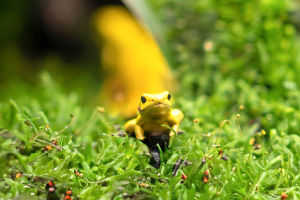In efforts to protect wildlife, many people focus on issues like poaching, habitat destruction, and the illegal wildlife trade.
While these are crucial concerns, one of the most significant threats to species around the world is often overlooked: climate change.
The rise in global temperatures and the shifting of weather patterns caused by excessive greenhouse gas emissions are rapidly altering ecosystems, putting immense pressure on wildlife. The good news? Each of us has the power to reduce our carbon footprint, and in doing so, contribute to the protection of endangered species. Here's how reducing your personal carbon footprint can directly benefit wildlife and how you can make an impact.
The Link Between Carbon Emissions and Wildlife
Wildlife and ecosystems around the world are increasingly vulnerable to the effects of climate change. As temperatures rise, many species are forced to adapt or relocate, but not all have the ability to do so.
Coral reefs, home to diverse marine life, are being bleached and killed by rising ocean temperatures. Moreover, changing weather patterns can lead to mismatches between when food is available and when animals need it for survival.
Beyond temperature changes, the increase in extreme weather events—such as storms, droughts, and floods—further disrupts habitats. Animals that depend on predictable environments are finding it increasingly difficult to survive, while the plants they rely on may no longer grow in those areas.
For instance, many migratory species like birds and butterflies are finding that their traditional migration patterns no longer align with the availability of food or suitable breeding grounds.
In essence, reducing carbon emissions is not just an environmental issue—it's a crucial step in safeguarding the future of countless species.
How Your Carbon Footprint Affects Wildlife
Each time you drive your car, fly on an airplane, or consume energy from fossil fuels, you are contributing to the increase in carbon emissions. These emissions create a blanket effect in the atmosphere, trapping heat and causing the Earth's temperature to rise.
This global warming disrupts ecosystems, changing everything from the timing of seasonal events to the very structure of habitats.
For wildlife, the consequences are far-reaching:
1. Loss of Habitat: Many species depend on specific climate conditions. With global temperatures rising, some habitats—such as rainforests, wetlands, and coastal areas—are being destroyed. Species like the orangutan, which depend on tropical rainforests, are facing shrinking living spaces as deforestation and climate change take their toll.
2. Food Chain Disruptions: Climate change can alter the availability of food sources, affecting species up and down the food chain. For example, some insects are hatching earlier due to warmer temperatures, but their predators, such as birds, may not be migrating at the same time, leading to mismatches in the timing of food availability.
3. Increased Disease Risk: Warmer temperatures can facilitate the spread of diseases, affecting both humans and wildlife. For example, malaria and other vector-borne diseases are spreading to new areas as the climate warms, putting species at risk. Wildlife like amphibians, which are already susceptible to diseases like chytrid fungus, are particularly vulnerable.
Simple Ways to Reduce Your Carbon Footprint
The good news is that there are countless ways you can reduce your carbon footprint and directly help protect wildlife. Here are some easy, effective steps you can take:
1. Reduce Car Usage and Opt for Public Transport
One of the biggest contributors to carbon emissions is the burning of fossil fuels in personal vehicles. By using public transportation, carpooling, cycling, or walking, you reduce the amount of CO2 released into the atmosphere. Even switching to an electric car is a significant step toward reducing your personal carbon emissions.
2. Switch to Renewable Energy
If possible, consider switching to a renewable energy provider or installing solar panels. Traditional power sources like coal and natural gas are among the biggest offenders when it comes to carbon emissions. By choosing wind or solar power, you're significantly reducing the carbon footprint of your household.
3. Eat a Plant-Based Diet
The agriculture industry, particularly livestock farming, is a major contributor to carbon emissions. Livestock farming, in particular, is a leading source of methane, a potent greenhouse gas. Reducing your consumption of meat and dairy, or switching to plant-based alternatives, can have a positive impact on the environment and wildlife.
4. Reduce, Reuse, Recycle
The production and disposal of goods require energy and raw materials, both of which contribute to carbon emissions. By recycling and reducing your waste, you minimize the demand for new products and the energy needed to make them.
Buying fewer single-use plastics and supporting sustainable brands also reduces the overall environmental impact.
5. Conserve Water and Energy
Simple steps like turning off lights when you leave a room, using energy-efficient appliances, and taking shorter showers can have a big impact on your overall carbon footprint.
Additionally, ensuring your home is well-insulated reduces the need for heating and cooling, which is another key area where energy consumption contributes to carbon emissions.
6. Support Conservation Efforts
One of the most direct ways to protect wildlife from climate change is to support organizations and efforts that work to preserve natural habitats and ecosystems. Donating to or volunteering with conservation groups helps fund critical research, conservation programs, and the protection of endangered species.
The Role of Governments and Businesses in Tackling Climate Change
While individual actions are important, the role of governments and businesses in addressing climate change cannot be overstated. Policy changes supporting the shift to renewable energy, stricter emission regulations, and protection of critical habitats are essential for meaningful progress.
Likewise, businesses that reduce their carbon footprint, adopt sustainable practices, and focus on green technologies are playing a key role in mitigating climate change.
One promising example is the global push toward a "carbon-neutral" economy, where businesses, governments, and individuals strive to balance out their carbon emissions by investing in carbon offset programs or reducing emissions to zero. In this context, wildlife protection becomes a shared responsibility, with each player contributing toward the preservation of the planet's biodiversity.
Conclusion
As the effects of climate change continue to accelerate, the preservation of wildlife has become an increasingly urgent issue. By reducing our individual carbon footprints, we can help to slow the pace of global warming, protect habitats, and safeguard the future of endangered species.
Small, everyday changes—like reducing car use, conserving energy, and eating more plant-based foods—may seem minor individually, but together they can have a significant impact. If we all take action, we can create a world where both humans and wildlife thrive in harmony. It's time to act—for the benefit of the planet and its inhabitants.


